Growing climbing plants in containers transforms any space into a lush vertical garden. Whether you’re working with a tiny balcony or a sprawling patio we’ll show you how to maximize your growing potential by thinking vertically. Container gardening with climbing plants offers incredible flexibility – you can move your green walls wherever you need them most.
We’ve discovered that climbing plants in pots aren’t just space-savers they’re absolute showstoppers. From fragrant jasmine cascading down your deck railings to colorful morning glories creating natural privacy screens these versatile plants deliver maximum impact with minimal square footage. The best part? You don’t need years of gardening experience to succeed.
Ready to create your own stunning vertical oasis? We’ll walk you through everything from selecting the perfect climbing varieties to choosing containers that’ll keep your plants thriving for seasons to come. Let’s turn those bare walls and empty corners into breathtaking living art.
Choose the Right Container for Your Climbing Plants in Pots
Selecting the perfect container sets the foundation for your climbing plants’ success and determines whether they’ll thrive or struggle in their vertical journey.
Size Requirements for Different Plant Types
Small climbing plants like sweet peas and nasturtiums flourish in containers measuring 12-18 inches wide and equally deep. These compact climbers don’t develop extensive root systems and can create stunning displays without overwhelming smaller spaces.
Medium-sized climbers such as clematis and honeysuckle demand containers at least 20-24 inches in diameter with depths of 18-20 inches. We recommend these dimensions because established vines need adequate space for their expanding root networks to support vigorous growth patterns.
Large climbing varieties including climbing roses and grape vines require substantial containers measuring 30 inches or wider with depths reaching 24-30 inches. Robust root systems in these plants need generous space to anchor heavy foliage and support years of vertical development.
Drainage Considerations for Potted Climbers
Drainage holes serve as the most critical feature in any climbing plant container. We position multiple holes across the bottom surface rather than relying on single central openings to prevent water accumulation around sensitive root zones.
Drainage layers using materials like gravel, broken pottery shards, or expanded clay pebbles create essential barriers between soil and standing water. Adding 2-3 inches of these materials at the container bottom ensures excess moisture flows away from plant roots effectively.
Soil mixture selection impacts drainage performance significantly in container environments. We blend standard potting soil with perlite or coarse sand at ratios of 3:1 to improve water flow while maintaining nutrient retention for healthy plant development.
Material Options for Long-Term Growth
Terracotta containers provide excellent breathability for root systems through their porous walls. Natural clay materials regulate moisture levels effectively but require more frequent watering during hot weather conditions and may crack during freeze-thaw cycles.
Plastic planters offer lightweight portability and consistent moisture retention ideal for mobility needs. Modern plastic containers resist weather damage and provide insulation benefits, though they may not offer the aesthetic appeal of natural materials.
Wooden containers deliver natural insulation properties and complement garden aesthetics beautifully. Cedar and teak varieties resist rot naturally, while treated pine options provide budget-friendly alternatives that last several growing seasons with proper maintenance.
Metal containers including galvanized steel and aluminum provide durability and modern styling options. We recommend choosing powder-coated finishes to prevent rust and reduce heat absorption that could damage delicate root systems during summer months.
Select the Best Climbing Plants in Pots for Your Space
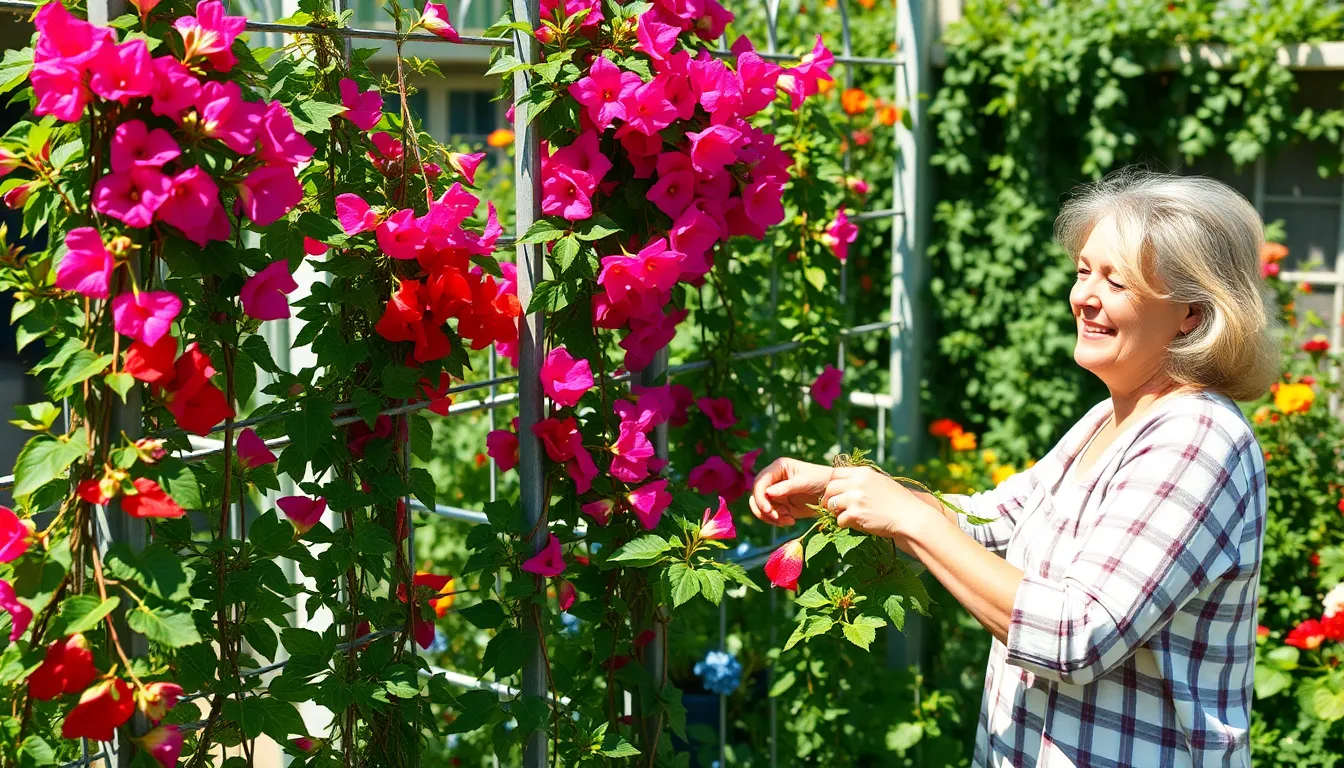
Now that you’ve got the right container setup, let’s explore the best climbing plants that’ll transform your space into a vertical garden paradise.
Fast-Growing Vines for Quick Coverage
Chocolate Vine (Akebia quinata) tops our list for vigorous growth that’s still manageable in containers. This remarkable climber produces flowers with a mild chocolate scent and grows rapidly while remaining controllable in pots.
Cup and Saucer Vine (Cobaea scandens) delivers impressive results with its ability to reach 10-20 feet in a single season. We love how this vigorous climber produces fragrant purple or white flowers that attract pollinators to your container garden.
Morning Glory offers the easiest option for beginners wanting quick results during spring and summer months. These annual vines require minimal maintenance while providing fast coverage for trellises and supports.
Wisteria creates dramatic impact with its cascading flowers and vigorous growth habit when planted in larger containers. Honeysuckle varieties like Lonicera x brownii ‘Dropmore Scarlet’ also provide rapid coverage alongside fragrant, showy blooms.
Flowering Climbers for Colorful Displays
Sweet Pea (Lathyrus odoratus) brings incredible fragrance and colorful ruffled flowers to container gardens. These annual vines prefer cooler weather and perform best during spring and fall seasons.
Climbing Roses like ‘Gertrude Jekyll’ provide classic garden beauty in compact varieties perfect for containers. We recommend these for gardeners wanting traditional elegance with manageable growth.
Bleeding Heart Vine (Clerodendrum thomsoniae) produces striking white and red flowers on evergreen foliage. This unique climber thrives in partial shade with consistently moist soil conditions.
Bougainvillea excels in warm climates where it offers bright, long lasting bracts in vibrant colors. These hardy climbers create stunning displays on trellises while tolerating container growing conditions exceptionally well.
Clematis varieties like ‘Madame Julia Correvon’ work perfectly in small to medium pots while producing abundant colorful blooms. Popular compact varieties make excellent choices for container growing with proper support structures.
Evergreen Options for Year-Round Interest
Ivy provides the most reliable year round coverage with its hardy evergreen nature. We find this climber extremely easy to maintain in containers while offering consistent green foliage through all seasons.
Bleeding Heart Vine serves double duty as both a flowering climber and evergreen option for subtropical container gardens. This versatile plant maintains its decorative appeal throughout the year.
Climbing Hydrangea offers lush green foliage year round with the bonus of seasonal flowers when planted in larger containers. These substantial climbers create impressive vertical displays while maintaining their structure through winter months.
Passion Flower adapts well to container conditions while producing exotic blooms alongside evergreen foliage. We recommend this option for gardeners wanting unique flowers combined with year round coverage.
Provide Proper Support Systems for Climbing Plants in Pots
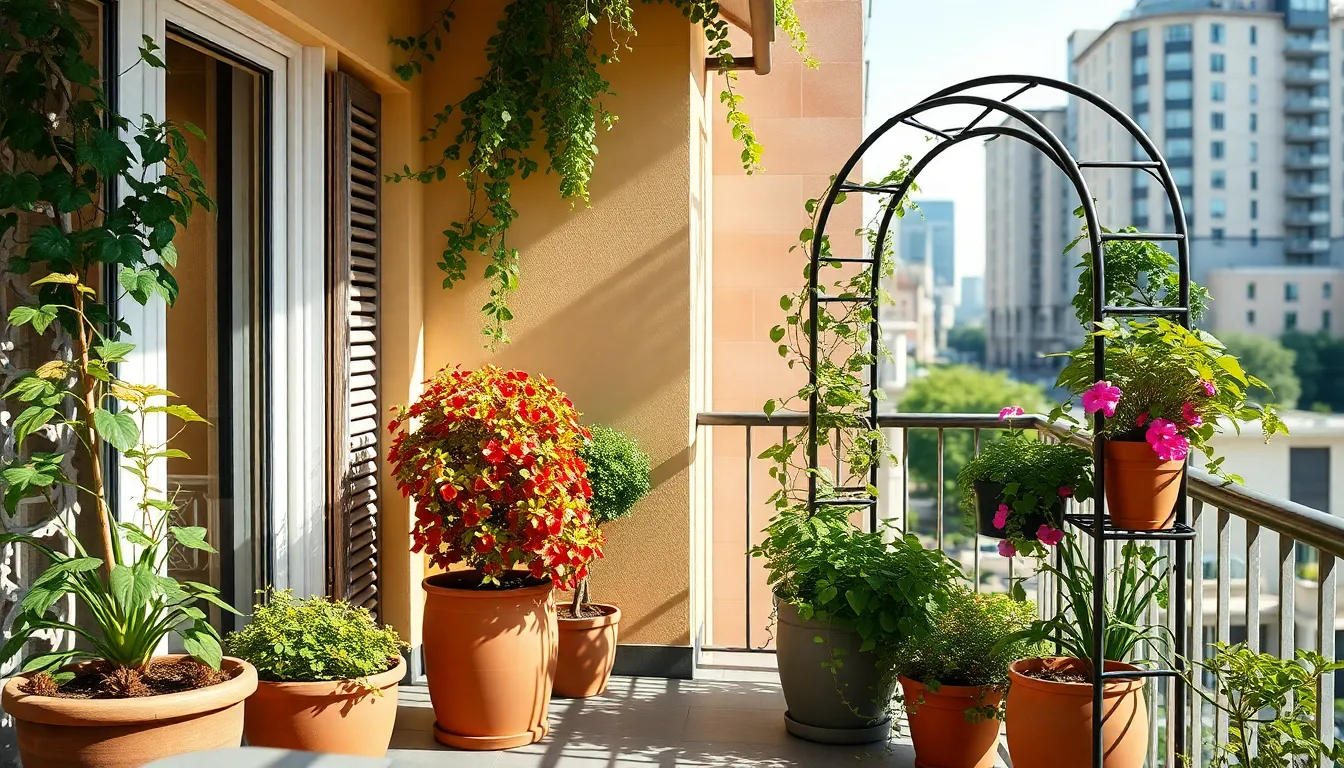
Creating a successful vertical garden requires more than just selecting the right plants and containers. Proper support systems ensure our climbing plants grow healthily while maximizing both space and visual appeal.
Trellis Installation Techniques
Steel and powder-coated options offer the most durability for outdoor container gardens. We recommend choosing galvanized or powder-coated steel trellises that can withstand weather conditions while supporting heavy vine growth throughout multiple seasons.
Direct attachment methods work best for most potted climbing plants. We insert sturdy trellises directly into the potting medium or position them securely behind containers to ensure stability as plants mature.
Freestanding designs create stunning focal points on patios and balconies. These trellises don’t require wall mounting and can be moved along with containers to optimize sunlight exposure or create different garden arrangements.
Wall-mounted options maximize vertical space in smaller areas. We attach these trellises to walls or fences, allowing containers to be positioned nearby while plants climb the mounted structure.
Stakes and Cages for Smaller Climbers
Slender stakes provide ideal support for delicate climbing plants like sweet peas and pole beans. We insert these supports directly into container soil, creating simple vertical guides for lightweight vines.
Reusable plastic stakes offer gentle support without damaging tender stems. These lightweight options work perfectly for annual climbers that need basic upward guidance during their growing season.
Metal climbing cages accommodate slightly larger plants while maintaining container portability. We use these cage-style supports for plants that produce heavier growth but still fit within medium-sized containers.
Soft ties and plant clips secure stems without causing damage. We combine these accessories with stakes to create flexible support systems that adjust as plants grow taller.
Wall-Mounted Support Options
Lattice panels create attractive displays while saving valuable floor space. We secure these panels to walls or balcony railings, positioning containers nearby so climbing plants can reach and attach naturally.
Decorative arches and obelisks enhance visual appeal while providing functional support. These mounted structures serve as both garden art and practical climbing frameworks for our container plants.
Wall anchoring systems ensure safety and stability for heavier climbing plants. We use appropriate screws and anchors based on wall material to support the combined weight of the structure and mature vines.
Balcony-exact answers work well for apartment gardeners with limited space. We mount compact trellises or wire grids to balcony rails, creating vertical growing space without compromising floor area for containers.
Prepare the Ideal Growing Medium for Climbing Plants in Pots
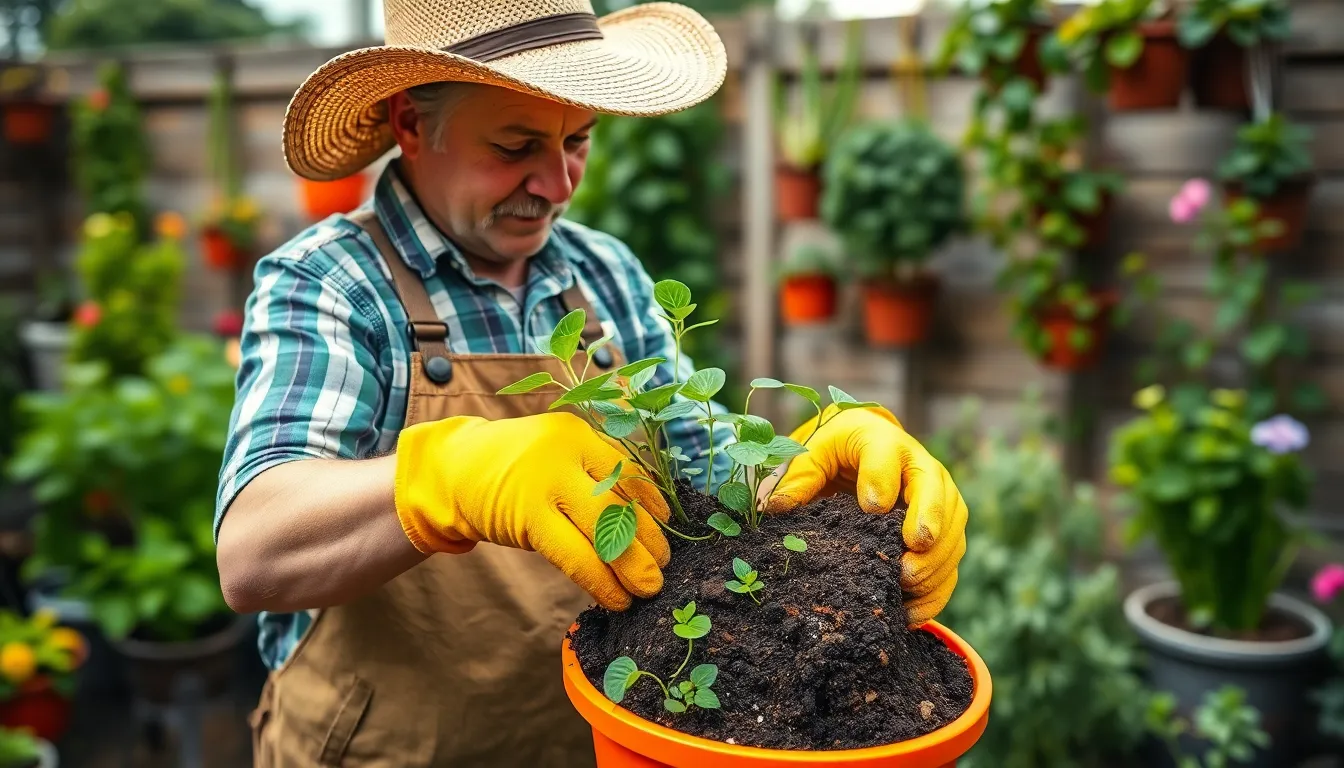
Creating the right foundation for your climbing plants starts with selecting a soil mix that balances drainage, nutrition, and moisture retention. We’ll walk you through the essential components that make potted vines thrive in containers.
Soil Mix Requirements for Container Growing
Container grown climbers need a specialized blend that differs from regular garden soil. We recommend combining 40-50% high quality potting soil with 20-30% compost for essential nutrients and improved soil structure. Adding 10-20% perlite or coarse sand creates the drainage that prevents root rot while maintaining adequate moisture levels.
Organic matter like well rotted manure enhances the soil’s ability to hold nutrients without becoming waterlogged. This combination allows roots to expand easily while providing the consistent moisture that climbing plants require. Since containers have limited soil volume, each component plays a crucial role in supporting vigorous vine growth.
Loose soil texture becomes especially important for climbing plants because their extensive root systems need room to develop. We’ve found that mixing these materials in the proper ratios creates an environment where roots can access both water and oxygen efficiently.
Fertilizer Needs for Potted Vines
Potted climbing plants require regular feeding because container soil has limited nutrient reserves compared to garden beds. We suggest using balanced water soluble fertilizers with equal nitrogen, phosphorus, and potassium ratios like 10-10-10 or 20-20-20 every 2 to 4 weeks during growing season.
Slow release granular fertilizers offer an alternative feeding method when incorporated into the soil mix at planting time. These provide steady nutrition over several months without frequent applications. Organic options like fish emulsion or seaweed extracts stimulate healthy foliage development and enhance flowering performance.
Regular feeding becomes critical because frequent watering washes nutrients from container soil faster than ground plantings. We apply fertilizers according to package directions and monitor plant response to adjust feeding schedules as needed.
pH Considerations for Optimal Growth
Most climbing plants perform best in slightly acidic to neutral soil with pH levels between 6.0 and 7.0. This range ensures optimal availability of essential nutrients including nitrogen, phosphorus, and potassium that support vigorous growth.
Testing your soil mix before planting helps determine if amendments are necessary. We add lime to raise pH when soil tests too acidic, while elemental sulfur lowers pH in alkaline conditions. Maintaining proper pH levels directly affects how well your climbing plants can absorb nutrients from the soil.
Proper pH management supports overall plant health and maximizes flowering potential in varieties like clematis and sweet peas. We check pH periodically throughout the growing season to ensure conditions remain optimal for nutrient uptake.
Master Watering Techniques for Climbing Plants in Pots
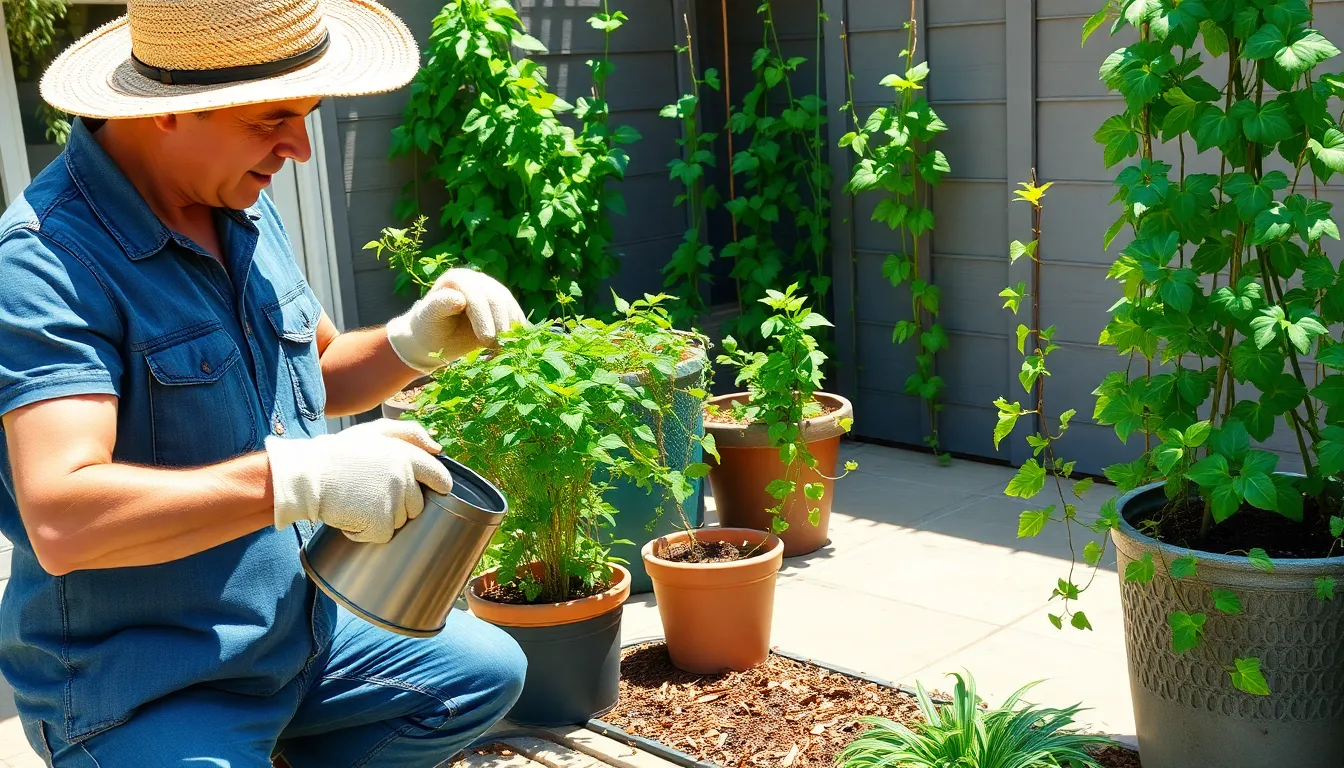
Watering becomes the most critical skill we need to master when growing climbing plants in containers. Container plants dry out significantly faster than their ground-planted counterparts, requiring us to develop precise watering strategies that ensure deep root hydration without causing waterlogged conditions.
Frequency Guidelines for Different Seasons
Growing season watering demands our daily attention from spring through summer, as container-grown climbing plants typically need water most days during active growth periods. We’ll find ourselves watering nearly every day during dry spells, especially when temperatures rise and plants are actively producing new growth and flowers.
Cooler seasons require us to adjust our watering schedule significantly, reducing frequency while still monitoring soil moisture levels closely. During dormant periods, we should water less often but never allow the soil to become completely dry, as even dormant plants need some moisture to survive.
Newly planted climbers receive special attention in our watering routine, requiring consistent moisture until their root systems establish in the container environment. Monthly feeding combined with regular watering from early spring through summer supports optimal growth and flowering for varieties like Clematis.
Signs of Over and Under-Watering
Overwatering symptoms appear when soil remains soggy or waterlogged, creating conditions that suffocate plant roots and promote disease. We’ll notice yellowing leaves or wilting even though wet soil conditions, plus potential root rot or fungal growth around the root zone.
Underwatering indicators show up as dry soil several inches below the surface, accompanied by leaves that wilt, droop, or develop crispy brown edges. Slow or stunted growth often results from insufficient moisture, preventing plants from reaching their full potential.
Soil moisture monitoring helps us determine the perfect watering timing by checking that the top inch of soil feels dry to the touch before adding more water. We should water the soil directly rather than the foliage to prevent disease while encouraging deep root development.
Mulching Strategies for Moisture Retention
Organic mulch layers work effectively when we apply bark chips, compost, or even decorative pebbles on the soil surface in our containers. These materials help retain moisture while keeping roots cool during hot weather, reducing the frequency of our watering sessions.
Evaporation reduction becomes especially important for container plants that naturally dry out quickly in outdoor conditions. We can achieve this by using mulching materials that create a protective barrier between the soil and air, maintaining consistent moisture levels.
Root zone protection involves top dressing with pebbles or planting low-growing companion plants that shade the soil surface. This strategy prevents overheating and excessive moisture loss, creating optimal growing conditions for our climbing plants while adding visual interest to our container displays.
Implement Strategic Placement for Climbing Plants in Pots
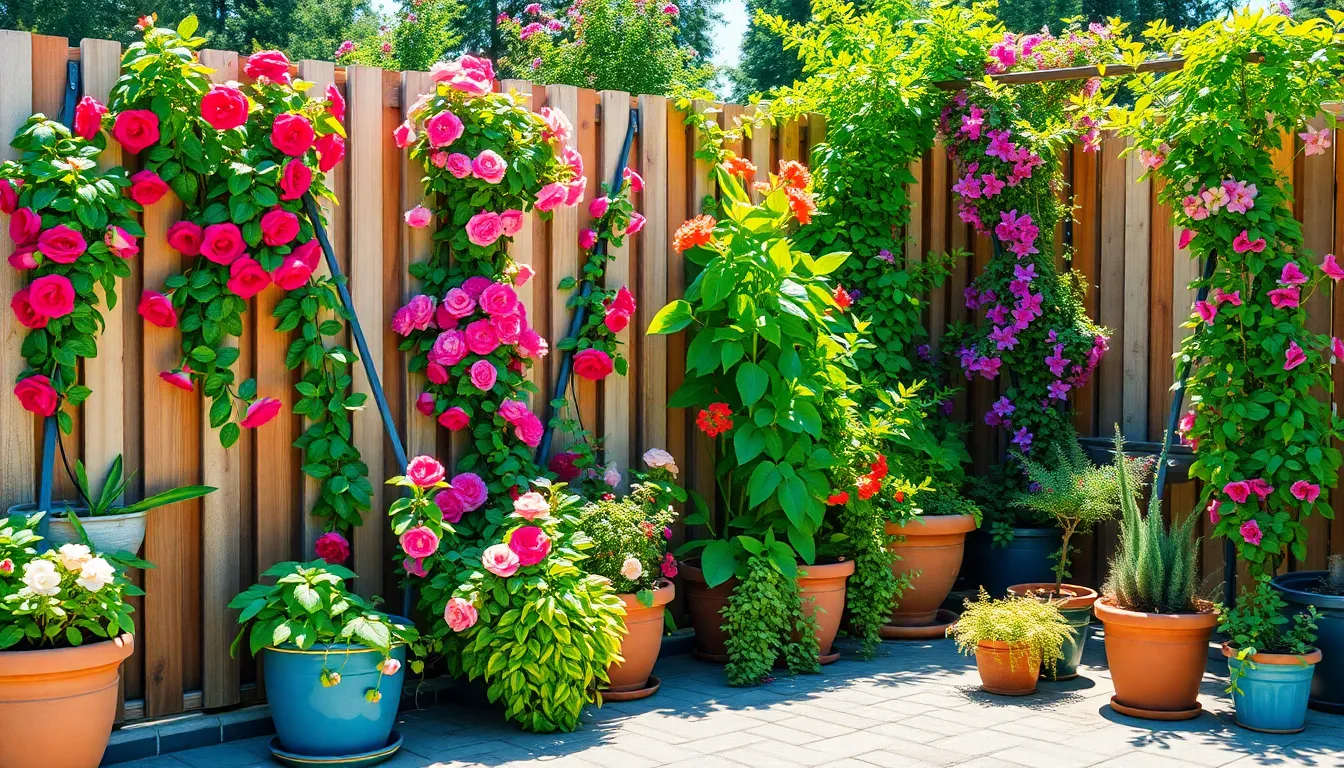
Strategic placement determines the success of our potted climbing plants more than any other factor. We must consider multiple environmental elements when positioning our containers to create thriving vertical displays.
Light Requirements for Various Climber Types
Full sun climbers like climbing roses and many clematis varieties demand six or more hours of daily sunlight to produce their most spectacular blooms. We position these containers in the brightest spots of our gardens, patios, or balconies where morning and afternoon sun reaches them consistently.
Partial shade climbers offer us flexibility in darker corners of our outdoor spaces. Honeysuckle and certain passionflower varieties thrive with filtered light or morning sun followed by afternoon shade, making them perfect for areas under overhangs or near larger structures.
Cool season climbers such as sweet peas prefer mild spring and fall conditions rather than intense summer heat. We place these containers where they’ll receive morning sun but afternoon protection, and we often need to replant them as temperatures rise beyond their comfort zone.
Matching our plant selections to available light conditions ensures healthy growth and abundant flowering throughout the growing season.
Wind Protection Considerations
Potted climbing plants face unique wind challenges since containers create top heavy structures that can easily topple over. We position our pots near walls, fences, or other sheltered areas to reduce direct wind exposure and protect both plant and container.
Sturdy support structures become even more critical in windy locations. We install trellises and supports that can anchor our plants while withstanding strong gusts, preventing damage to both stems and root systems.
Container weight plays a crucial role in wind resistance. We choose heavier materials like terracotta or stone pots over lightweight plastic options to prevent tipping, especially for taller climbing varieties that catch more wind.
Temporary protection helps us manage severe weather conditions. We move smaller containers to protected areas during storms or create temporary windbreaks around larger pots that can’t be relocated easily.
Seasonal Movement for Optimal Conditions
Winter protection requires us to move containers indoors or to sheltered locations in colder climates. We relocate pots before freezing temperatures damage root systems, particularly for less hardy climbing species that struggle with container exposure.
Temperature sensitive varieties like sweet peas and climbing vegetables need seasonal repositioning as conditions change. We move these containers to cooler spots during hot summer months or transition them to warmer areas as fall approaches.
Moisture monitoring becomes more intensive with seasonal changes since container soil dries quickly in summer heat and may retain too much water during cooler periods. We adjust our watering schedules and pot positions based on seasonal moisture needs.
Nutrient management requires our attention as container soil depletes faster than garden beds. We monitor our plants more closely during active growing seasons and supplement with regular feeding to maintain vigorous growth in our portable vertical gardens.
Maintain Your Climbing Plants in Pots Throughout the Year
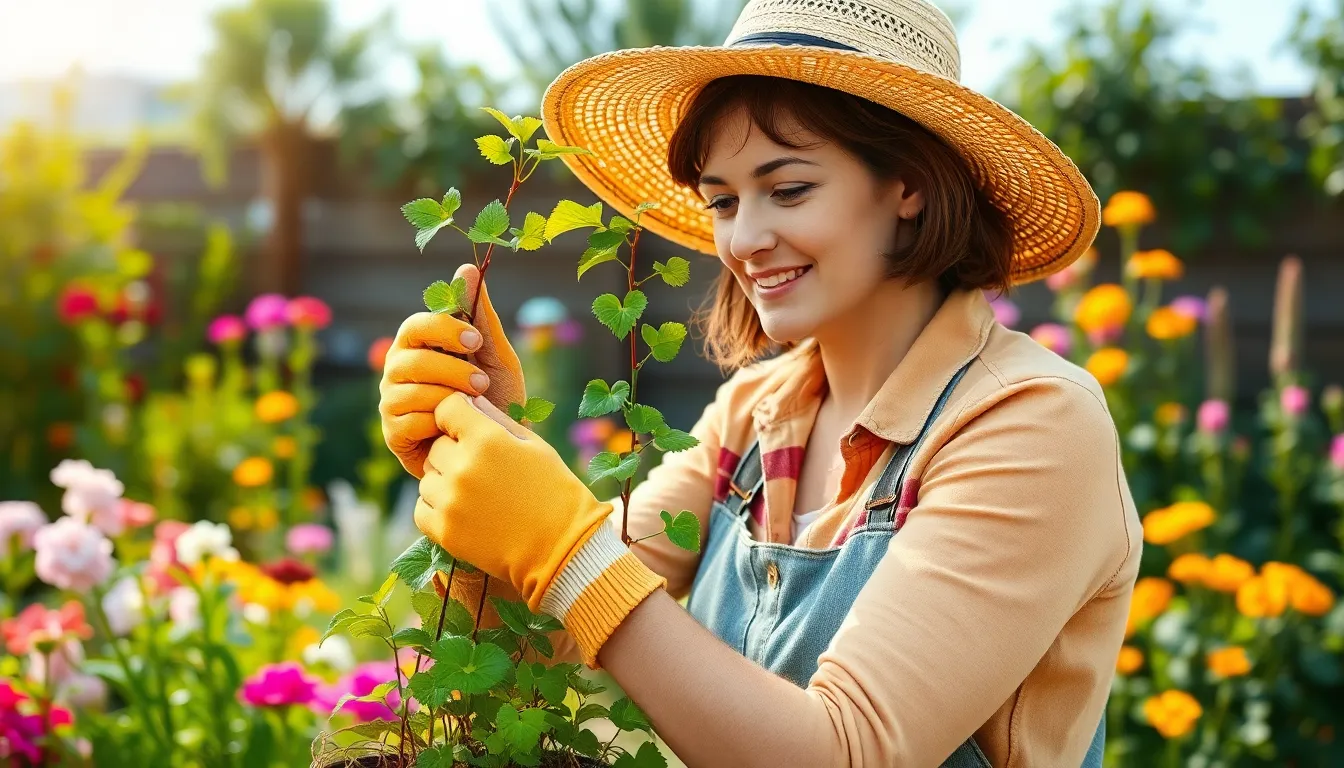
Successful container climbing requires consistent care throughout all seasons to ensure vigorous growth and abundant flowering. We’ll guide you through the essential maintenance practices that keep your potted climbers thriving year after year.
Pruning Schedules for Healthy Growth
Remove old or dead wood regularly to encourage new, vigorous growth and improved flowering throughout your climbing plants’ growing seasons. We recommend timing your pruning based on exact plant varieties since requirements vary significantly between species.
Climbing roses benefit from early spring pruning when dormancy breaks and new growth begins to emerge. Cut back weak or damaged canes and shape the plant to maintain your desired form and size.
Clematis pruning depends entirely on flowering type with some varieties requiring post-bloom trimming while others need late winter cuts. Group 1 clematis (early flowering) should be pruned immediately after blooming, Group 2 (large-flowered hybrids) need light pruning in early spring, and Group 3 (late flowering) require hard pruning in late winter.
Regular pruning in containers prevents plants from becoming root-bound while maintaining manageable size and shape for your available space. This practice also improves air circulation around the plant, reducing disease risks common in container environments.
Pest and Disease Prevention
Potted climbing plants face increased susceptibility to pests like aphids and spider mites due to limited air circulation compared to ground-planted varieties. We monitor our containers weekly for early signs of infestation to catch problems before they spread.
Maintaining good hygiene prevents most disease issues by removing dead leaves promptly and ensuring proper drainage in all containers. Clean up fallen debris around the base of plants since decomposing material can harbor fungal spores and pest eggs.
Avoiding overly wet soil reduces fungal disease risks that commonly affect container plants in humid conditions. We ensure drainage holes remain clear and adjust watering schedules based on weather conditions and soil moisture levels.
Inspect plants regularly for signs of trouble including yellowing leaves, webbing, or unusual spots that indicate pest or disease problems. Early treatment with appropriate organic or chemical controls proves most effective when problems are caught quickly.
Winter Care for Cold-Hardy Varieties
Cold-hardy climbers in pots require critical winter protection since container roots face more exposure than in-ground plants during freezing temperatures. We move portable containers to sheltered, frost-free locations whenever possible to protect root systems.
Insulate pots by wrapping them with bubble wrap or hessian to provide an extra barrier against temperature fluctuations that can damage root systems. This protection proves especially important for larger containers that can’t be moved indoors.
Apply thick mulch on top of soil to protect surface roots from freezing and help maintain consistent soil temperatures throughout winter months. We use organic materials like straw or shredded leaves that also break down to improve soil structure.
Hardy climbers like honeysuckle, jasmine, ivy, and Virginia creeper tolerate cold better and can survive outdoors with minimal protection when planted in appropriate containers. These varieties make excellent choices for gardeners in colder climates who want year-round vertical interest.
Troubleshoot Common Problems with Climbing Plants in Pots
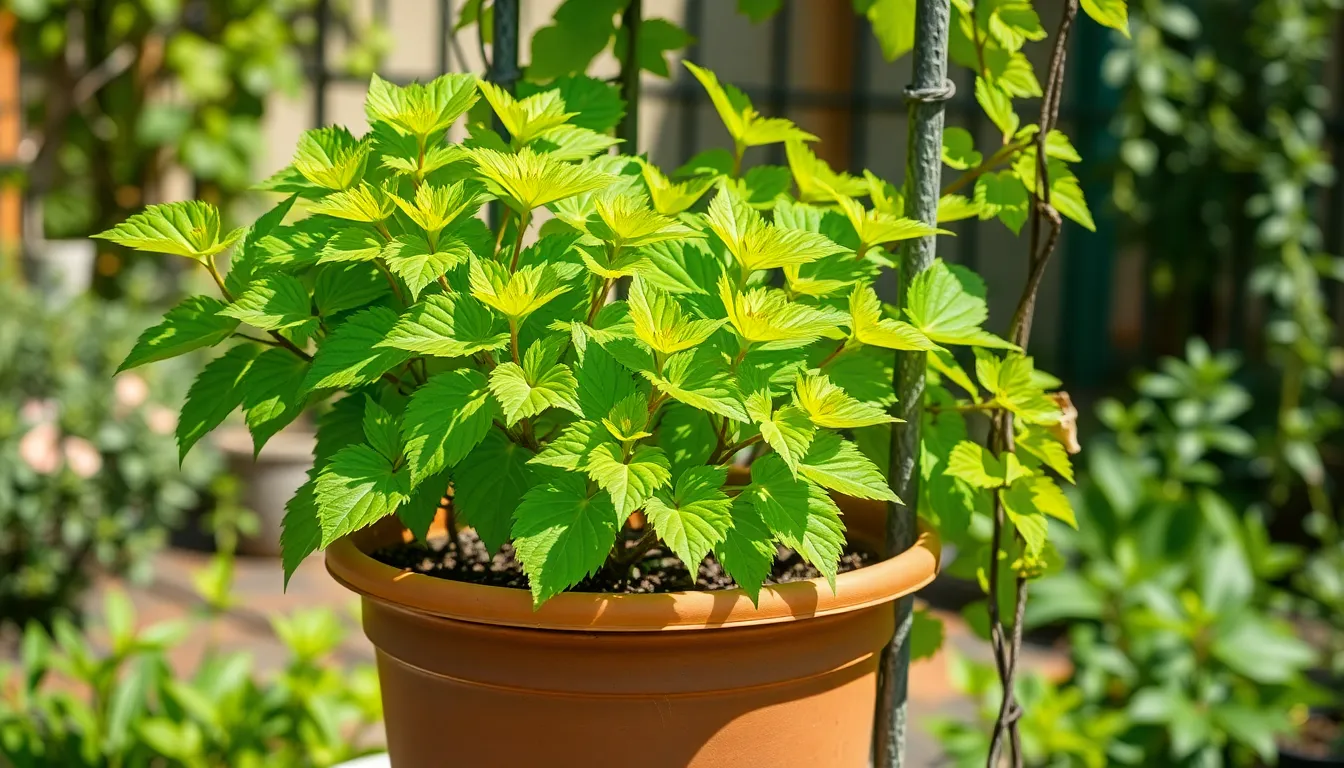
Even with proper care and maintenance, climbing plants in containers can face exact challenges that require quick identification and targeted answers. We’ll help you diagnose and resolve the most common issues that affect potted climbers.
Root-Bound Issues and Answers
Root bound conditions develop when climbing plants outgrow their containers and roots circle tightly around the pot’s interior walls. This restriction severely limits nutrient and water uptake, causing stunted growth and poor flowering performance.
Signs of root bound plants include:
- Roots growing through drainage holes
- Water pooling on the soil surface instead of absorbing
- Yellowing leaves even though adequate feeding
- Reduced flowering or fruiting
Immediate Answers:
- Repot your climber into a container that’s 2-4 inches wider than the current pot
- Gently tease out circling roots before replanting to encourage outward growth
- Trim any damaged or excessively long roots with clean pruning shears
- Use fresh potting mix to provide renewed nutrients for healthy development
Prevention starts with choosing appropriately sized containers from the beginning. Small climbers like sweet peas need 12-18 inch pots, while larger varieties like climbing roses require containers 30 inches or wider for long term success.
Yellowing Leaves and Nutrient Deficiencies
Yellowing foliage commonly indicates nitrogen deficiency or overwatering in container grown climbing plants. Potted climbers depend entirely on us for their nutritional needs since they can’t access ground soil nutrients.
Nitrogen Deficiency Symptoms:
- Lower leaves turning yellow first
- Pale green new growth
- Reduced flowering
- Slow overall growth rate
Overwatering Signs:
- Yellow leaves with brown spots
- Mushy stems at soil level
- Fungal growth on soil surface
- Waterlogged drainage trays
Treatment Strategies:
- Apply balanced granular fertilizer every 4-6 weeks during growing season
- Check soil moisture before watering by inserting finger 2 inches deep
- Improve drainage by adding perlite or coarse sand to existing soil
- Mulch soil surface to retain moisture while preventing waterlogging
Regular feeding becomes essential after climbing plants have been in containers for several years. We recommend using slow release fertilizers that provide consistent nutrition throughout the growing season.
Support Structure Failures
Support structure problems can cause climbing plants to collapse, grow improperly, or suffer physical damage from inadequate anchoring systems. Weak trellises, broken stakes, or insufficient ties create serious challenges for healthy vertical growth.
Common Support Failures:
- Flimsy trellises bending under plant weight
- Stakes breaking during windy conditions
- Plant ties cutting into stems as growth increases
- Inadequate height for mature plant size
Reinforcement Answers:
- Install galvanized or powder coated steel supports before plants become too large
- Use soft plant ties that expand with stem growth
- Provide bridging canes for self clinging climbers like ivy to reach main supports
- Secure freestanding trellises with guy wires or weighted bases
Timing matters when addressing support issues. We should evaluate and upgrade support systems during dormant seasons when plants can handle disturbance better. Strong supports prevent not only structural collapse but also protect climbing plants from wind damage and promote proper growth patterns.
Choose durable materials rated for your climber’s mature weight and size. Heavy flowering vines like wisteria need substantially stronger supports than lightweight annuals like morning glories.
Conclusion
Growing climbing plants in pots opens up endless possibilities for creating stunning vertical gardens in any space. We’ve covered everything from selecting the right containers and soil mixtures to providing proper support systems and maintaining healthy growth throughout the seasons.
With the knowledge of watering techniques placement strategies and troubleshooting common issues you’re now equipped to transform any bare wall or empty corner into a thriving green oasis. Whether you choose fast-growing vines colorful flowering climbers or evergreen varieties your container garden will bring beauty and life to your outdoor space.
Start small with one or two climbing plants and gradually expand your vertical garden as you gain confidence. Your potted climbers will reward your efforts with spectacular displays that change with the seasons.
Frequently Asked Questions
What size container do I need for climbing plants?
Container size depends on the plant variety. Small climbers like sweet peas need 12-18 inch containers, medium climbers such as clematis require 20-24 inch pots, and large varieties like climbing roses need containers 30 inches or wider. Always ensure containers have proper drainage holes and consider the plant’s mature size when selecting.
What are the best climbing plants for containers?
Top choices include fast-growing vines like Chocolate Vine and Cup and Saucer Vine, flowering climbers such as Sweet Pea and Climbing Roses, and evergreen options like Ivy and Climbing Hydrangea. Choose based on your space, light conditions, and desired aesthetic for year-round interest.
How do I provide support for climbing plants in pots?
Install trellises directly attached to pots, use freestanding designs for flexibility, or mount supports on walls. For smaller climbers, use stakes and cages. Use soft ties and plant clips for gentle support, and consider decorative elements like lattice panels or arches for both function and visual appeal.
What type of soil should I use for potted climbing plants?
Use a specialized mix combining high-quality potting soil with compost and perlite or coarse sand. This blend provides proper drainage, nutrition, and moisture retention. Regular feeding with balanced fertilizers and monitoring pH levels ensures optimal nutrient availability for vigorous growth and flowering.
How often should I water climbing plants in containers?
Water daily during growing season as containers dry out faster than ground plantings. Reduce frequency in cooler months. Check soil moisture regularly and watch for signs of over or under-watering. Apply organic mulch to retain moisture and keep roots cool while reducing evaporation.
Where should I place my climbing plant containers?
Position full sun climbers in bright locations and partial shade varieties in darker areas. Provide wind protection with sturdy support structures. Consider seasonal movement – relocate containers for winter protection and adjust positions based on changing temperature and moisture needs throughout the year.
How do I maintain climbing plants in pots year-round?
Follow pruning schedules specific to each plant variety to encourage healthy growth. Conduct regular pest and disease inspections, maintain good hygiene, and apply winter protection for cold-hardy varieties using insulation and mulch. Consistent maintenance ensures vibrant, healthy vertical gardens.
What common problems affect climbing plants in containers?
Common issues include root-bound conditions, yellowing leaves from nutrient deficiencies, and support structure failures. Signs include stunted growth, poor flowering, and unstable plants. Solutions involve repotting when needed, adjusting watering and fertilizing practices, and reinforcing or replacing inadequate support systems.







